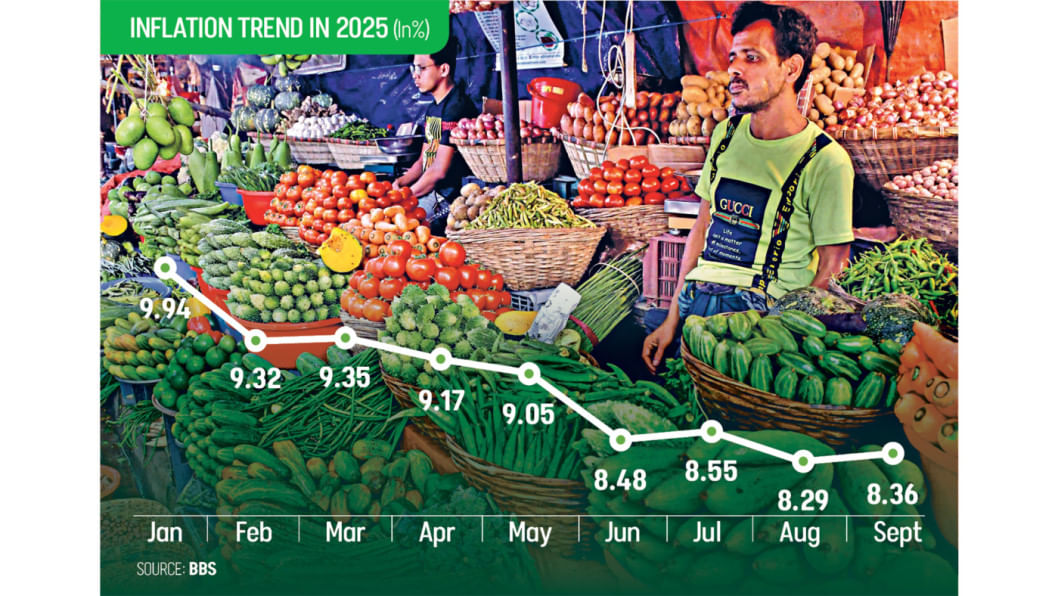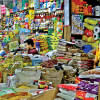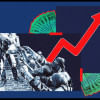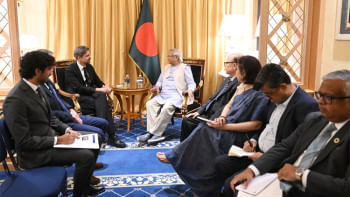Non-food costs fuel inflation to 8.36% in Sept

Bangladesh's headline inflation rose slightly to 8.36 percent in September from 8.29 percent in August, according to data from the Bangladesh Bureau of Statistics.
The increase was driven mainly by non-food prices, which climbed to 8.98 percent from 8.90 percent, while food inflation moved up to 7.64 percent from 7.60 percent.
Although September's rates were below the previous year's levels, when food prices rose 10.4 percent and non-food prices 9.5 percent, average inflation has stayed above 8 percent so far this fiscal year, exceeding the government's target of 6.5 percent.
The 12-month moving average stands at 9.45 percent, indicating that high prices have persisted over the past year.
Economists say the persistence of inflation is linked to structural factors and policy choices.
"The changes aren't very significant," said Zahid Hussain, a former lead economist at the World Bank's Dhaka office. "Inflation is in a rigid mode, rising one month, falling the next, but staying above eight percent."
"The gap between the current average and the target is substantial. It is worrying," added Hussain, who was also a member of the committee that prepared the White Paper on the State of the Bangladesh Economy.
Hussain said the exchange rate is the central bank's key tool for controlling inflation and that Bangladesh Bank is following a risk-balancing approach.
He said, "There was an opportunity to let the exchange rate appreciate, which could have reduced import prices and production costs.
"But they did not allow that, fearing that a lower dollar price would squeeze exporters' margins, already under pressure due to recent US reciprocal tariffs."
He noted that an appreciation of the taka could also reduce remittance inflows and increase import demand.
According to Hussain, Bangladesh Bank is using this period to build reserves. "It even bought dollars today [Monday]."
The economist summarised the logic behind the central bank's stance as threefold: to protect exports, support remittances, and build reserves.
He also argued that allowing the dollar rate to fall could help reduce inflation.
"There's no risk-free option. Whichever way you go, there's a trade-off. Bangladesh Bank should reconsider. Reducing inflation is urgent as it affects ordinary people directly.
If that cannot be achieved, it is a serious concern," he said.
"By keeping the exchange rate fixed, two things happen. First, the economy misses the direct benefit a stronger taka could bring in lowering import and production costs."
Second, he added, liquidity in the market has increased.
When Bangladesh Bank buys dollars, it injects taka into the market, and that money is not sterilised. "As a result, risk-free rates have fallen to single digits, which weakens the contractionary stance of monetary policy."
On the possibility of a policy rate cut, Hussain said: "I don't see any reason for a reduction before December based on current data. They will likely wait for the next monetary policy update."
Ashikur Rahman, principal economist at the Policy Research Institute (PRI) of Bangladesh, said he expects "inflation to follow a moderate downward path in the coming months," provided political disruptions and supply-side pressures remain limited.
In rural areas, non-food inflation rose to 9.40 percent from 9.28 percent, one of the largest gaps among indicators.
Commenting on this, Rahman said there could be minor supply disruptions in rural areas but cautioned, "The change is very small. We must interpret it carefully."
Hussain said non-food inflation is rising mostly in health, education, and miscellaneous expenses.
"Since this category covers many items, it is difficult to identify exactly what is driving the increase," he said.

 For all latest news, follow The Daily Star's Google News channel.
For all latest news, follow The Daily Star's Google News channel. 







Comments